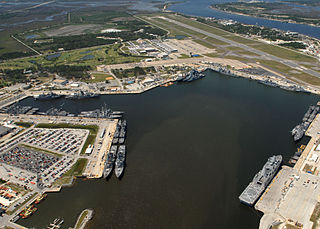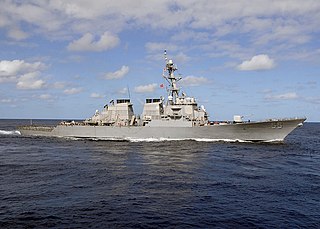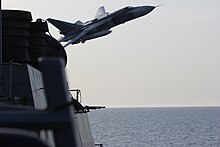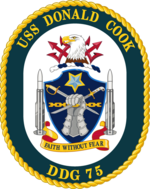
The Arleigh Burke class of guided-missile destroyers (DDGs) is a United States Navy class of destroyer centered around the Aegis Combat System and the SPY-1D multi-function passive electronically scanned array radar. The class is named for Admiral Arleigh Burke, an American destroyer officer in World War II and later Chief of Naval Operations. With an overall length of 505 to 509.5 feet, displacement ranging from 8,300 to 9,700 tons, and weaponry including over 90 missiles, the Arleigh Burke-class destroyers are larger and more heavily armed than many previous classes of guided-missile cruisers.

USS Arleigh Burke (DDG-51), named for Admiral Arleigh A. Burke, USN (1901–1996), is the lead ship of the Arleigh Burke-class guided-missile destroyers. She was laid down by the Bath Iron Works company at Bath, Maine, on 6 December 1988; launched on 16 September 1989; and commissioned on 4 July 1991.

The Spruance-class destroyer was developed by the United States to replace the many World War II–built Allen M. Sumner- and Gearing-class destroyers, and was the primary destroyer built for the United States Navy during the 1970s and 1980s. It was named in honor of U.S. Navy Admiral Raymond A. Spruance, who successfully led major naval battles in the Asiatic-Pacific Theater during World War II such as the Battle of Midway and the Battle of the Philippine Sea.

The third USS Luce (DLG-7/DDG-38) was Farragut-class guided missile destroyer of the United States Navy that served from 1962 until discarded in 1992. The ship was named for Rear Admiral Stephen B. Luce (1827–1917). Luce was sold for scrapping in 2005.

Naval Station Mayport is a major United States Navy base in Jacksonville, Florida. It contains a protected harbor that can accommodate aircraft carrier-size vessels, ship's intermediate maintenance activity (SIMA) and a military airfield with one asphalt paved runway (5/23) measuring 8,001 ft × 200 ft.

USS The Sullivans (DDG-68) is an Arleigh Burke-class Aegis guided missile destroyer. She is the second ship of the United States Navy to be named for the five Sullivan brothers – George, Francis, Joseph, Madison, and Albert Sullivan, aged 20 to 27 – who lost their lives when their ship, USS Juneau, was sunk by a Japanese submarine in November 1942 in the Naval Battle of Guadalcanal. This was the greatest military loss by any one American family during World War II.

USS Stout (DDG-55) is the fifth Arleigh Burke-class guided missile destroyer. Built for the United States Navy by Ingalls Shipbuilding, she was commissioned on 13 August 1994 and she is currently home-ported in Naval Station Norfolk. She is part of Destroyer Squadron 26. Stout is named for Rear Admiral Herald F. Stout, who distinguished himself as the commanding officer of the destroyer USS Claxton during World War II. In November 1943, Commander Stout received two Navy Crosses in the span of three weeks for his actions in the Pacific. Stout aided Destroyer Squadron 23 in sinking five heavily armed Japanese warships and damaging four others during the Solomon Islands campaign as well as sinking four more Japanese warships and damaging two others to establish a beachhead on Bougainville Island. Stout was ordered on 13 December 1988, the keel was laid down on 8 August 1991, she was launched on 16 October 1992 and commissioned on 13 August 1994. As of July 2020 the ship is part of Destroyer Squadron 26 based out of Naval Station Norfolk.

USS Carney (DDG-64) is the 14th Arleigh Burke-class destroyer in the United States Navy. The guided-missile destroyer is the first to be named after Admiral Robert Carney, who served as Chief of Naval Operations during the Eisenhower administration.

USS Benfold (DDG-65) is a Flight I Arleigh Burke-class destroyer in the United States Navy. She is a multi-mission platform capable of anti-aircraft warfare (AAW) with the powerful Aegis Combat System suite and anti-aircraft missiles, anti-submarine warfare (ASW), with towed sonar array, anti-submarine rockets, anti-surface warfare (ASUW) with Harpoon missiles, and strategic land strike using Tomahawk missiles. Benfold was one of the first ships fitted with the Aegis Ballistic Missile Defense System and during the 2010 Stellar Daggers exercise was the first ship to simultaneously engage a ballistic missile and a cruise missile.

USS Ross (DDG-71) is an Arleigh Burke-class guided-missile destroyer in the United States Navy. She is the second Navy ship to be named Ross, the first Navy ship named for Medal of Honor recipient Donald K. Ross and the 21st destroyer of her class. The first Ross, DD-563, was named for David Ross, a captain in the Continental Navy.

USS Porter (DDG-78) is an Arleigh Burke-class destroyer in the United States Navy. Porter is the fifth US Navy ship to be named after US Navy officers Commodore David Porter, and his son, Admiral David Dixon Porter. This ship is the 28th destroyer of her class. Porter was the 12th ship of this class to be built at Ingalls Shipbuilding in Pascagoula, Mississippi. She was laid down on 2 December 1996, launched and christened on 12 November 1997, and commissioned 20 March 1999, in Port Canaveral, Florida.

USS Roosevelt (DDG-80) is an Arleigh Burke-class destroyer in service with the United States Navy. She is named in honor of both President Franklin D. Roosevelt and his wife, the then-First Lady Eleanor Roosevelt. This ship is the 30th destroyer of her class. USS Roosevelt was the 13th ship of this class to be built at Ingalls Shipbuilding in Pascagoula, Mississippi, and construction began on 15 December 1997. She was launched on 10 January 1999 and was christened on 23 January 1999. On 14 October 2000 the commissioning ceremony was held at Naval Station Mayport, Florida.

USS Farragut (DDG-99) is an Arleigh Burke-class destroyer in the United States Navy. She is the fifth Navy ship named for Admiral David Farragut (1801–1870), and the 49th ship of the Arleigh Burke class.

USS Michael Murphy (DDG-112) is the 62nd ship of the Arleigh Burke class of guided missile destroyers in the United States Navy. She is named for Medal of Honor recipient Lieutenant Michael P. Murphy (1976–2005). Murphy was posthumously awarded the Medal of Honor for his actions during Operation Red Wings in Afghanistan in June 2005. He was the first sailor awarded the Medal of Honor since the Vietnam War. The ship's name was announced by Secretary of the Navy, Donald C. Winter on 7 May 2008. The ship was christened on 7 May 2011, Murphy's birthday, by her sponsor Maureen Murphy, Michael Murphy's mother. The ship is part of Destroyer Squadron 31 of Naval Surface Group Middle Pacific.

USS Ralph Johnson (DDG-114) is an Arleigh Burke-class destroyer of the United States Navy. Ralph Johnson is the 64th ship of the class and was commissioned on 24 March 2018.

USS John Finn (DDG-113) is an Arleigh Burke-class destroyer in service with the United States Navy. The contract to build her was awarded to Ingalls Shipbuilding of Pascagoula, Mississippi, on 15 June 2011. Ingalls has been a subsidiary of Huntington Ingalls Industries (HII) since its acquisition in April 2001. Prior to the award, Ingalls had constructed 28 Arleigh Burke-class destroyers, the last one of which was USS William P. Lawrence. On 15 February 2011, Secretary of the Navy Ray Mabus announced the ship's name to be John Finn after John William Finn, the first Medal of Honor recipient of World War II. He was so honored for machine-gunning Japanese warplanes for over two hours during the December 1941 attack on Pearl Harbor despite being shot in the foot and shoulder, and suffering numerous shrapnel wounds. He retired as a lieutenant after thirty years of service and died at age 100 in 2010.

USS Rafael Peralta (DDG-115) is an Arleigh Burke-class guided missile destroyer in the United States Navy. The destroyer can operate with a Carrier Strike Group (CSG), Expeditionary Strike Group (ESG), as an element of a Surface Action Group (SAG), or independently. The ship can conduct a variety of missions in support of national military strategy. From peacetime presence and crisis management to sea control and power projection, 115 will be capable of carrying out Integrated Air and Missile Defense (IAMD), Undersea Warfare (USW), Surface Warfare (SW), and Strike Warfare (STW) in multi-threat environments.

USS Thomas Hudner (DDG-116) is an Arleigh Burke-class destroyer. The $663 million contract to build her was awarded on 28 February 2012, to Bath Iron Works, of Bath, Maine. On 7 May 2012, Secretary of the Navy Ray Mabus announced the ship name would be named Thomas Hudner in honor of U.S. naval aviator Thomas Hudner, who was awarded the Medal of Honor for his actions in trying to save the life of his wingman, Ensign Jesse L. Brown, during the Battle of Chosin Reservoir, in the Korean War.

USS Paul Ignatius (DDG-117) is an Arleigh Burke-class destroyer of the United States Navy. She is named for Paul Ignatius who served as United States Secretary of the Navy under President Lyndon Johnson from 1967 to 1969. Ignatius had previously served as a lieutenant in the Navy during World War II. Paul Ignatius is the second of eight planned Flight IIA "technology insertion" ships, which contains elements of the Flight III ships.

Destroyer Squadron 60 is a destroyer squadron of the United States Navy. Destroyer Squadron 60 is one of three U.S. Navy destroyer squadrons permanently based outside the continental United States.























